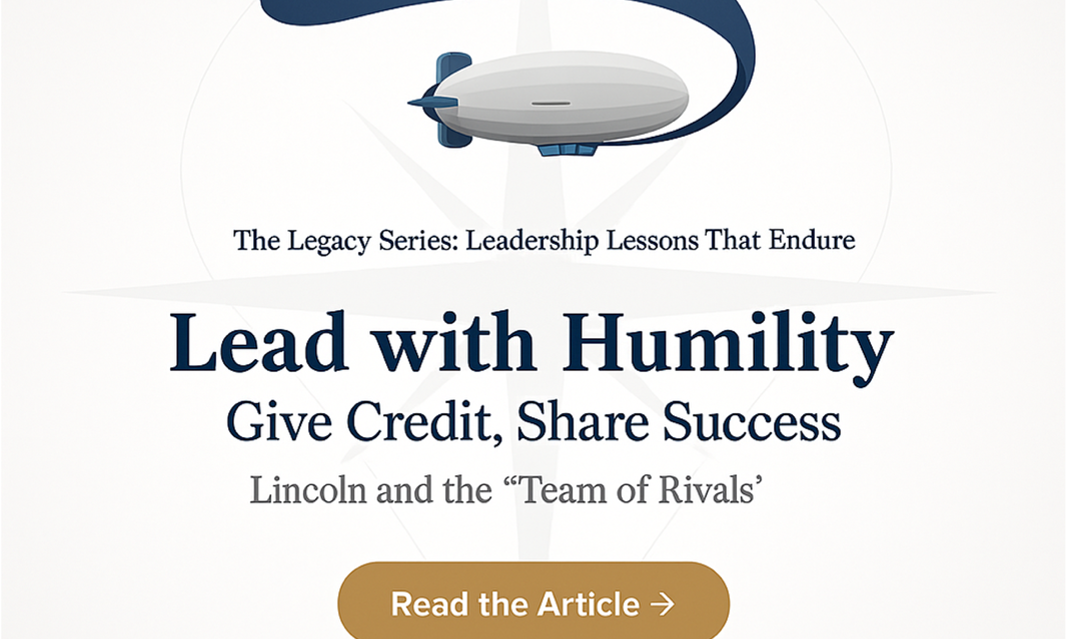The Legacy Series: Leadership Lessons That Endure
In the late 1960s, restaurateur Bob Farrell, founder of Farrell’s Ice Cream Parlors, received a letter from a frustrated customer. The man had been visiting Farrell’s for years. He loved the place. But on his last visit, when he asked for an extra pickle with his burger—a small request he’d made many times before—the waiter refused.
“Sorry, sir,” he said. “It’s company policy to charge for extras.” The customer walked out angry and never came back.
When Bob read the letter, he didn’t scold the employee. He blamed the culture. Somewhere along the line, his business had stopped empowering people to act with kindness.So he called a company meeting and shared a message that would become legendary:
“When a customer wants a pickle—give ’em the pickle!”
It wasn’t about the pickle. It was about principle. Bob told his employees, “If it makes the customer happy, just do it. Don’t hide behind policy. Don’t ask for permission. Be good people. Take care of others.”
That simple mindset shift changed everything. Employees began seeing customers as individuals, not transactions. They smiled more, connected more, and took pride in doing the right thing. The energy in the restaurants changed—customers were happier, and so were employees. Because when people feel trusted to be human, everyone wins.
The Leadership Lesson
Empowerment is about trusting people to act on principle, not policy. Policies create consistency. Principles create connection.
Every customer—and every employee—wants to be seen and treated like a person, not a number. When a company gets so rigid that employees can’t use common sense or empathy, it becomes robotic. Customers feel it instantly.
We’ve all experienced that moment: calling customer service or standing in line and realizing the person helping you isn’t really there. They’re following a script. They’re doing their job but not connecting. It feels cold, transactional, and exhausting. When employees are encouraged to think for themselves—to listen, to care, to be kind—the experience transforms. A small gesture, a genuine smile, or a simple “I understand” creates warmth that ripples throughout the organization.
Great service isn’t about efficiency—it’s about empathy.
When you build an environment that celebrates connection, your team doesn’t just serve customers—they energize them. That positivity spreads inward too. Work becomes more enjoyable. The atmosphere lightens. People start looking forward to their day because they know their job matters.
Great companies don’t just provide good service—they practice goodness.
My Perspective: Empowerment Builds Brands That Last
I actually learned the lesson of human connection long before I started leading companies—during a summer job in college. I worked for a brewery restaurant called Rock Bottom, and their management team made connection an integral part of the brand standard.
We were encouraged to do more than serve food—we were told to build relationships. Talk to customers. Learn their names. Ask about their day. Go the extra mile to make them feel welcome. We were even encouraged to sit down at the table for a minute and share a conversation. It was awesome!
Customers can get food and drinks anywhere. What made Rock Bottom special was how it made people feel. It was a place where people came not just to eat but to belong. That culture of genuine connection made us the busiest restaurant in Portland. We had lines out the door. We had people that came every day. We knew almost everyone who walked in.
That’s when it clicked for me: customer loyalty and powerful brands begin with human connection.
Years later, I had the privilege of spending time with the brand executives from Disneyland and I saw the same principle at work—just on a multibillion dollar scale. Disney’s leaders spend every waking moment focused on creating meaningful emotional connections. Every “cast member,” from janitor to performer to parking lot attendants, is trained to make people feel special. And that’s why Disney has one of the most valuable and beloved brands in the world.
The same rule applies inside companies. It starts with the ownership. It’s starts with management. I tell every leader and manager on my teams:
Be a real person. Make a real connection. Genuinely care about people.
Don’t treat your employees like cogs in a machine. Talk to them. Ask about their families. Show interest in their lives. When people feel seen and valued, they take ownership naturally, and that cultural energy flows outward.
When you share the mantra of genuine customer success, your employees will learn that behavior from how you treat them. Your employees will interact with customers the same way you interact with them. When leadership builds a culture of respect, kindness, and care, it doesn’t stop at the office walls. That culture cascades through the entire organization, to your partners, and to your clients.
Like Rock Bottom and Disney, we weave human connection into our training and onboarding. We don’t just teach systems—we teach EQ. We make sure every new hire understands not just what to do, but why it matters. They learn they’re part of something meaningful—and how to be meaningful in our clients’ lives.
Because when people care about people, brand loyalty and repeat customers follow.
Emotional Intelligence: The Heartbeat of Great Leadership
Emotional Intelligence—or EQ—is the ability to recognize, understand, and manage emotions in ourselves and others. It’s what allows people to listen with empathy, respond with patience, and build genuine trust.
While IQ might help you solve problems, EQ helps you lead people—and that’s what builds great teams, loyal customers, and strong cultures.
High-EQ organizations communicate better, adapt faster, and resolve conflict more effectively. Employees with strong emotional intelligence are better at reading situations, supporting teammates, and turning tense moments into opportunities for connection.
How to Build EQ in Your Organization
1. Model It.
Leaders set the emotional tone. Show calm under pressure, admit mistakes, and treat everyone with respect—especially when it’s difficult.
2. Teach Self-Awareness.
Encourage employees to pause before reacting. Simple habits like reflection or feedback sessions build emotional maturity over time.
3. Practice Empathy.
Ask, “What might this person be feeling right now?” before responding. Role-play real customer or coworker scenarios during training to reinforce empathy in action.
4. Normalize Open Conversation.
Create a culture where it’s okay to discuss challenges, stress, and emotions constructively. Emotional honesty strengthens relationships.
5. Recognize Emotional Wins.
Celebrate moments when an employee de-escalates a situation, comforts a client, or supports a teammate. Reward emotional leadership, not just performance metrics.
Developing EQ isn’t a training module—it’s a mindset.
When employees learn to connect emotionally, they don’t just follow instructions; they create experiences—for customers, for teammates, and for themselves.
How to Apply It in Your Business
1. Replace Policy with Principle.
Empower employees to make customer-first decisions. Encourage them to ask, “What’s the right thing to do?” not “What’s the rule?”
2. See the Individual.
Teach employees to recognize customers as people—remember names, preferences, and stories. Human connection drives loyalty.
3. Make Everyone a Brand Ambassador.
From entry-level to executive, every employee represents your brand’s values. Encourage them to treat customers like friends they want to see again.
4. Lead by Example.
Leaders set the tone. Talk to your employees. Ask about their lives. Listen to their ideas. Respect breeds respect.
5. Add Human Interaction to Training.
Make onboarding about people, not paperwork. Pair new hires with mentors, share customer stories, and connect values to real-life experiences.
6. Celebrate Acts of Goodness.
Publicly recognize employees who go above and beyond to help someone—inside or outside the company. Positivity is contagious.
Why It Works
According to Harvard Business Review, organizations that empower and emotionally engage employees see 21% higher profitability and 17% greater productivity⁸.
Forbes reports that trust-based workplaces experience stronger loyalty and lower turnover⁹.
And Daniel Pink’s research in Drive shows that autonomy, mastery, and purpose—not control—are the real motivators of performance¹⁰.
When leaders treat employees with humanity, employees treat customers with heart.
Final Thought
Bob Farrell’s “Give ’Em the Pickle” lesson isn’t really about customer service—it’s about human service.
It’s about being good people. It’s about connection. It’s about treating every person—customer or coworker—with kindness, dignity, and care. When leaders listen, employees follow. When employees care, customers feel it. And when customers feel valued, they come back—not just for what you sell, but for how you make them feel. That’s the true power of empowerment: it transforms policy into purpose, transactions into relationships, and workplaces into communities.
Be the Leader Who Lifts Others Higher
Great leadership isn’t just about vision—it’s about taking care of people. The most successful companies don’t just hire talent; they invest in their teams’ well-being.
Studies show that:
-
Companies with strong benefits programs see 56% lower turnover and 50% higher engagement (Gallup).
-
Organizations that prioritize employee well-being experience 21% greater profitability and 17% higher productivity (Harvard Business Review).
-
Employees who feel valued and supported are 4x more likely to recommend their company as a great place to work (SHRM).
That’s the power of care—it fuels loyalty, focus, and a culture people are proud to be part of.
At Benefit Airship, we believe every business deserves that advantage. We built the only employee benefits program that costs employers $0—yet delivers medical, dental, vision, mental health, and prescription benefits to every worker: full-time, part-time, or contract.
Our mission is simple: Help businesses grow by helping people thrive. Because great leaders don’t just build companies—they build communities. And when your people rise, your business soars.
Sources
⁸ Harvard Business Review – Managing for Motivation, Not Control
⁹ Forbes – Empowerment Is the New Leadership
¹⁰ Daniel Pink – Drive: The Surprising Truth About What Motivates Us
¹¹ Bob Farrell – Give ’Em the Pickle: The Power of Customer Service




